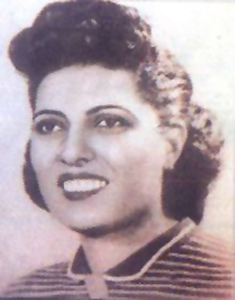Sameera Moussa facts for kids
Quick facts for kids
Sameera Moussa
|
|
|---|---|
 |
|
| Born | March 3, 1917 |
| Died | August 5, 1952 (aged 35) California, United States
|
| Nationality | Egyptian |
| Other names | Mother of Atomic Energy |
| Known for | "Atoms for Peace" |
| Awards | Order of Science and Arts |
| Scientific career | |
| Fields | Nuclear Physics |
Sameera Moussa (Egyptian Arabic: سميرة موسى) (March 3, 1917 – August 5, 1952) was an amazing Egyptian scientist. She was the very first female nuclear physicist from Egypt. A nuclear physicist studies the tiny parts that make up atoms and how they behave. Sameera earned a special degree called a doctorate in atomic radiation. She dreamed that her work would help create affordable medical treatments. She also hoped it would lead to using atomic energy for peaceful things, not for war. She even organized a big meeting called the Atomic Energy for Peace Conference. She was also the first woman to work as a professor at Cairo University.
Contents
Early Life and Education
Sameera Moussa was born in Gharbia Governorate, Egypt in 1917. Her mother sadly passed away from cancer. Her father was a well-known person who cared a lot about his community. He moved with Sameera to Cairo and bought a small hotel there.
Sameera's father wanted her to have a good education. She went to Kaser El-Shok primary school, which was one of the oldest schools in Cairo. After finishing primary school, she joined Banat El-Ashraf school. This school was actually built and managed by her father!
Sameera was a brilliant student. She got very high grades in high school. She could have chosen to study engineering, but she really wanted to join the Faculty of Sciences at Cairo University. In 1939, Sameera earned her Bachelor of Science degree in radiology. She got top honors for her research on how X-ray radiation affects different materials. Her professor, Dr. Moustafa Mousharafa, saw her talent. He helped her become a lecturer at the university. Later, she became the first assistant professor there. This made her the first woman to hold such a high university position. She was also the first woman to get a PhD in atomic radiation.
Nuclear Research for Peace
Sameera Moussa strongly believed in using Atoms for Peace. She famously said, "My wish is for nuclear treatment of cancer to be as available and as cheap as Aspirin". She worked very hard to make this happen. Through her intense research, she found a way that could help break apart the atoms of common, inexpensive metals like copper. This discovery could have led to cheaper ways to use nuclear energy.
Sameera organized the Atomic Energy for Peace Conference. She also encouraged a worldwide meeting called "Atom for Peace." Many important scientists were invited to this conference. They made suggestions for creating a group to protect people from nuclear dangers. Sameera strongly supported this idea. She also volunteered to help cancer patients in hospitals. This was very important to her because her own mother had fought a difficult battle with cancer.
Visits to the United States
Sameera Moussa received a special scholarship from the Fulbright Program. This allowed her to visit modern research places at California University in the United States. Because of her amazing work in nuclear research, she was allowed to visit secret US atomic facilities. This was a big deal! It caused a lot of discussion among scientists in the US because she was the first non-white person to be given this special permission.
She was offered many chances to live in the United States and become an American citizen. But Sameera turned them all down. She said, "Egypt, my dear homeland, is waiting for me." This showed how much she loved her country.
Her Writings and Contributions
Dr. Sameera Moussa was the first assistant professor at the Faculty of Sciences at Cairo University. It was even more impressive that she was the first woman at the university to get a high university job. This was thanks to her amazing PhD in atomic radiation from the 1940s.
She was inspired by earlier Muslim scientists, including her teacher, Dr. Moustafa Mashrafa. Sameera started writing about the work of Muhammad ibn Musa al-Khwarizmi, who helped create algebra. She also wrote many articles that explained nuclear energy. She wrote about how it works, its effects, and how to use it safely in simple terms. She also discussed the history and structure of the atom. She wrote about the dangers of nuclear fission technology and the properties of radiation and how they affect living things.
Sad Passing
On August 5, 1952, after her first visit to America, Sameera Moussa was planning to return home. However, she was invited on a trip. During the trip, the car she was in fell from a height, and she died right away.
Awards and Honors
Sameera Moussa received many awards for her hard work and contributions. Here are some of them:
- In 1953, the Egyptian Army honored her.
- In 1981, she was given the Order of Science and Arts, First Class, by the President of Egypt, Anwar Sadat.
- A laboratory at the Faculty of Science and a school in her village were named after her.
- Egyptian TV showed a TV series called The Immortal that told her life story.
- In 1998, on Egyptian Woman Day, it was decided to create a cultural center in her hometown named after her.
- A book was published that covered her life and all her scientific contributions.
See also
In Spanish: Samira Musa para niños

